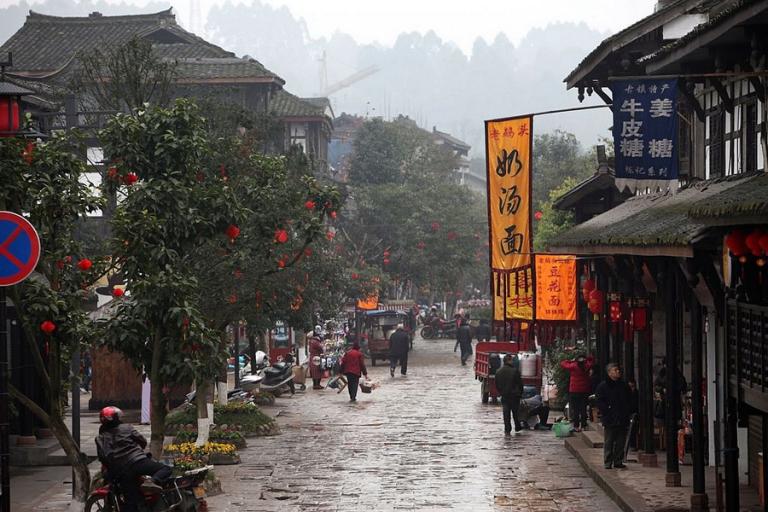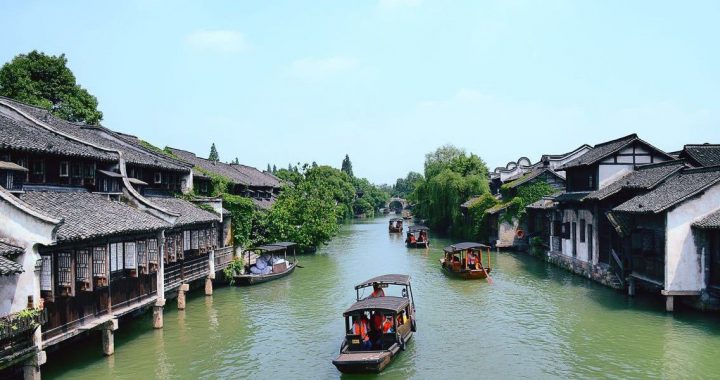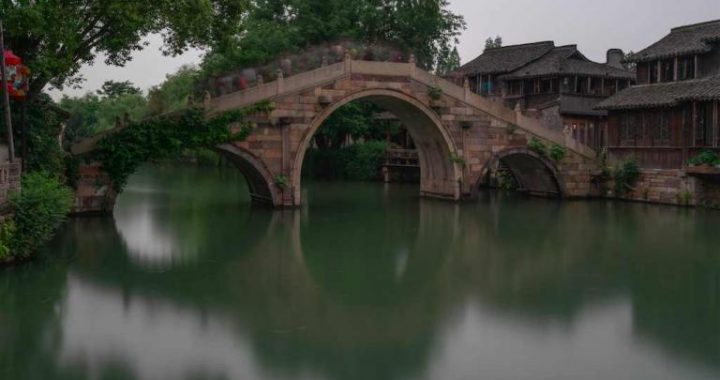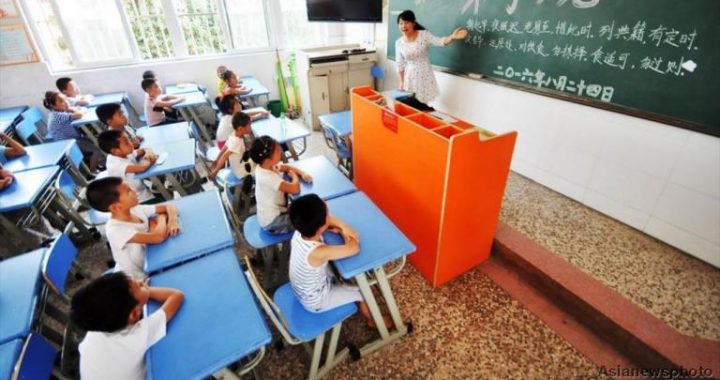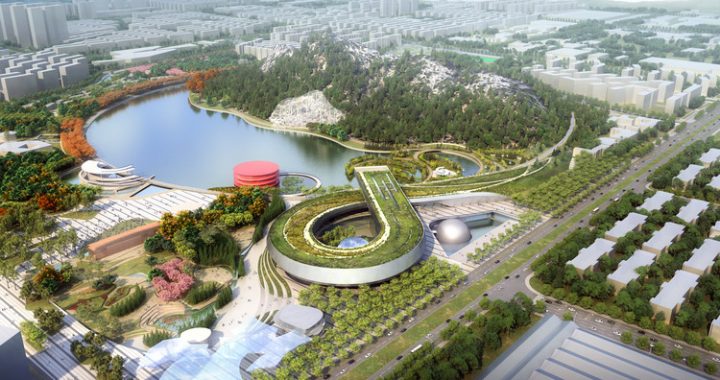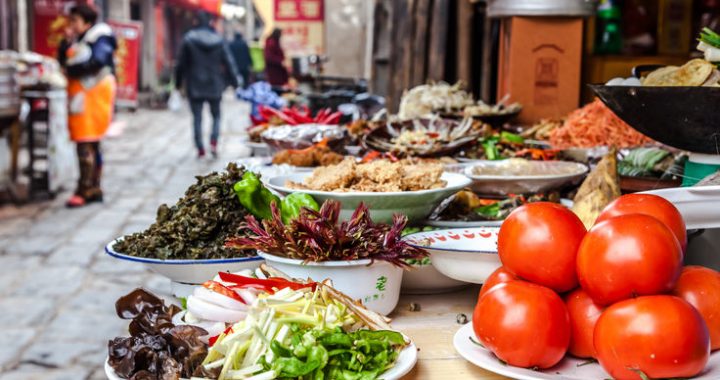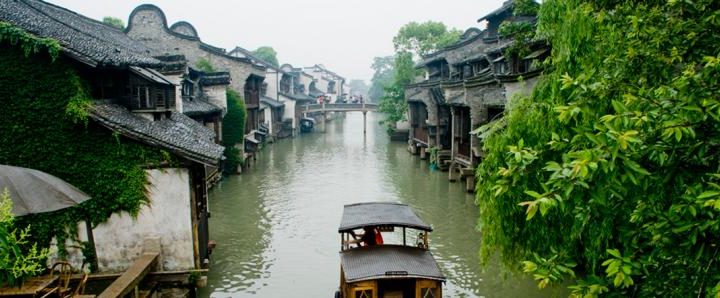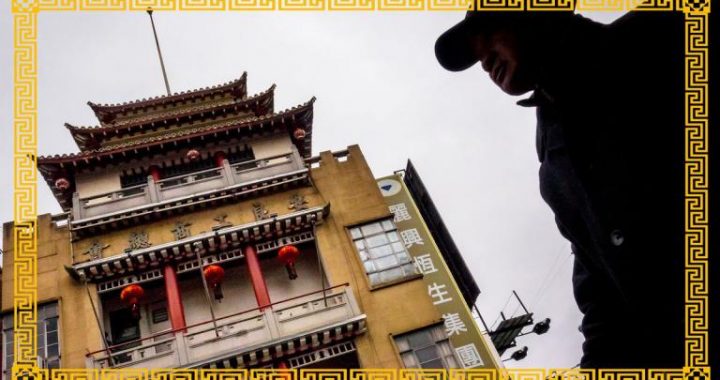The Town’s Pathway Through China’s History
39 min readWuzhen has lived through its water. Its many waterways hold the traveller’s attention. They weave through the town unwinding like the thread of a silk cocoon into the distance. Only when the eye has absorbed their paths does it turn back to the attractive wooden homes along the banks of these tamed streams.
Wuzhen is the sort of small ancient Chinese community which would have had a village storyteller, the Pingsbu Xiansheng. Pinghua, the art of storytelling, had always been a part of Chinese culture. It has even survived the cultural steam-roller of the internet into the twenty-first century. Such a man in the past was excused much of the hard fieldwork in return for providing evening entertainment through fabricating a fabulous tale, be it from the past,a tale of romance, misfortune or of war. Wuzhen could always carry old stories well.
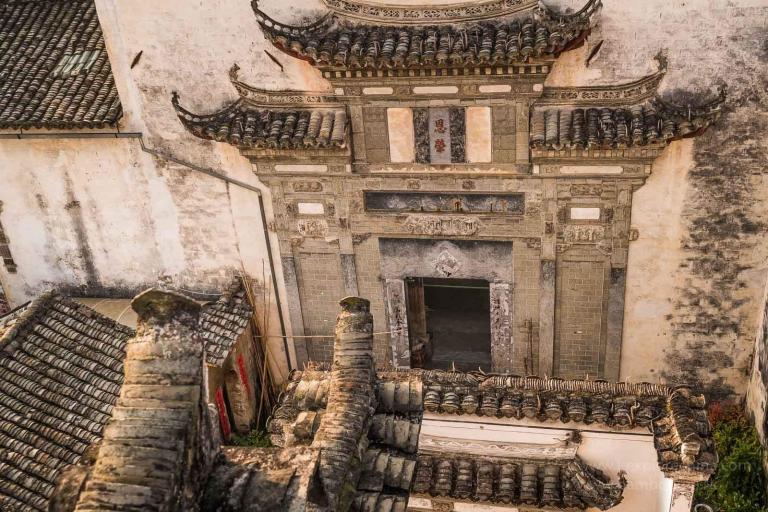
Usually both the storyteller and the town’s oldest grandfather would have been held in great respect by their contemporaries, the one for his imagination, the other for his memory of times long past coupled with the respect which is always paid to age in China.
If one or two inhabitants from centuries past could have revisited, they would have been content with much of modern Wuzhen. The streets are clean, its many bridges well maintained, the water clear and the houses in a better state of repair than they could ever remember. They might have concluded times had been good recently, as they often had been in the past. The Pingsbu Xiansbeng might have thought that there had been many fat years of rich harvests, decent landlords, with peace through the wisdom of a strong ruler in the distant capital beyond the mountains. There could be no other explanation for the good order of the town. The state of twenty-first-century Wuzhen might even have persuaded the storyteller to give one extra performance from outside the Taoist Xiuzhen Temple about the Immortals who had always protected the town and how everything had always looked as it did now and always would do so.
He would have been mistaken. By the end of the twentieth century, Wuzhen was dying. It was a worn skeleton whose shrunken skin of late nineteenth-century Qing houses barely covered its fragile bones. The time of the late Qing dynasty, from 1800 to 1900, had been the most recent period of thistown’s prosperity. They had been generally good years, although life was made very difficult during the Taiping Rebellion in the mid-1800s. The community suffered even more during the troubled years of the twentieth century through the collapse of imperial government, the long Japanese occupation of eastern China and the war through which Communism was established. The fatal blow on top of those events which made recovery almost impossible was the increasing economic irrelevance of the town. Wuzhen was on medical life-support by the end of the 1990s, and it was life-support that the nearby county-level city of Tongxiang could ill afford to provide.
Wuzhen, after years of gentle decline, then received a dramatic makeoverand, in the Chinese way, it has been completed in double-quick time. This was made possible through a classic example of how China’s socialist market economy works. The Tongxiang authorities made a partnership with a private company to establish a restoration programme. It would secure the structure of the past, deploy architecture from the present and engage with the future.
Only in this manner could the desperately needed financial support be sourced.
The renovation is merely the latest turn of Wuzhen’s wheel of fortune. The plan of the provincial decision-makers and the local investors was to attract visitors while transforming Wuzhen into a platform for the arts and the internet. Behindsuch plans there must also have been a simple desire from some less commercialsouls, sensitive to the value of the town’s cultural heritage, who simply wished the Yangtze water town to survive. This piece of China’s past is invaluable. Thus have three groups of conservationists, businessmen and state officials come together to place Wuzhen atop a three-legged stool which comprises the arts, tourism and the internet.
This newest character of the town is simply the latest chapter of the long story. Its fortunes have ebbed and flowed to the cadence of Chinese dynasties which moved their capitals from far away to close by, and then away again. As much of China’s past can be exposed through Wuzhen’s story, so the town reflects the manner in which China wishes to be judged at present. Wuzhen is a town and China a country with a rich cultural heritage which has nonethelessimmersed itself in new technology and culture. This is the message to the world from twenty-first-century Wuzhen.
Some of the earlier chapters of China’s ancient story bear repeating, in order to understand both the present reconstruction of the town and how it grew. Wuzhen’s star shone most brightly during the Southern Song dynasty between the twelfth and thirteenth centuries and then again from the 1360s to 1911when the Ming and Qing ruled. The present structure of Wuzhen suggests it is a town from the time of the late Qing. In fact its story started long before the sixth century.
There is abundant archaeological evidence from up to 7,000 years agowhich adds flesh to the length of Wuzhen’s story. This was when human habitation probably began in the area to the west of the Shanghai water basin.
Stone implements, paleontological remains, pottery and rice seeds confirm human occupation.A few thousand years later the lives of Wuzhen people will have been moulded by the Shang and Zhou cultures. Certainly Shang oracle bones, which were usually animal shoulder blades used to pose questions to the Gods, have been found there. The bones were inscribed with questions before being plunged into a cauldron in order that answers could be read from cracks caused through intense heat. They are still uncovered by farmers. After the Zhou, Wuzhen experienced the vicissitudes of the Spring and Autumn Period and the strife of the Warring States which led to the brutal first unification of China under the Qin dynasty in 221 BC.
There have been many imperial capitals of China. The four most famous are judged to be Beijing, Nanjing, Luoyang and Xi’ an, but there have been many others, from Kaifeng to Hangzhou. The majority of these seats of government have been distant from Wuzhen but some have been close. The benefits of proximity to the imperial court are obvious: money is spent by courtiers, and there are opportunities for patronage and of protection by imperial armies stationed nearby. Without a court nearby, such privileges would generally have been denied to these southern townsfolk. Their survival in the periods of peace when the court was at a great distance will have been largely dependent on trade. Happily for the folk of Wuzhen the rivers which wound through so much of Zhejiang province provided wonderful opportunities for trade.
Yet Wuzhen would never have been particularly isolated due to its natural wealth. Wuzhen is indubitably part of China’s ‘ land of plenty’,a concept, colloquially defined in China as a village possessing fish and rice’, Yumi Zhi Xiang, or as the West would have it in the Christian phrase a ‘ land flowing with milk and honey. Distant from the epicentres of many Chinese dynasties it mayhave been, but land generously endowed by nature will always be fought over.
So it was with Wuzhen. The rich earth which provides Wuzhen with its bounty is dark; the Chinese word for dark is wu and zhen simply denotes a town or community. This Chinese meaning of wu is the most probable source of the first syllable of Wuzhen. There are areas in Europe with a reputation for dark earth, about which, for example, the Russian novelist Mikhail Sholokhov wrote in the River Don novels. His south Russian soil was rich and dark; their land, like that of Wuzhen, was fought over by Cossacks.
The national background of China was complex in this long distant past. In 771BC the Western Zhou, the dynasty which had destroyed the Shang around 1046 BC, itself succumbed to invasion. Its successor, the Eastern Zhou, moved its capital to Luoyang in central China, modern-day Henan province, which lies 1,000 kilometres to the north of Wuzhen. The Zhou leader at the time went under the delightful name to the Western ear of King Ping, pronounced pin.
Yet the Zhou could only rule over an increasingly divided and fractious country. This was one of a number of eras in Chinese history where fissiparous, internecine strife was followed by descent into extreme chaos,a pattern whichstill frightens the leaders and the public of this nation in the twenty-firstcentury. Knowledge of their history persuades Chinas rulers that their country has a natural propensity to chaotic self-destruction. It is possible in these distant times that there was an earlier name for Wuzhen: Tan Jia Wan. Tan seems tohave been the name of the leading family, although they claim no place in historical records. It is possible that a family named Tan had occupied the bay (wan) in that area;a Wuzhen bridge was once called Tan /ia Qiao, although this earlier name is now little used.
Wuzhen fits into the Zhou dynasty through its location near the boundary of two warring states which existed during this chaotic period. They were the states of Wu and Yue. Most of the warlords had been subsumed by small states and those states themselves were dominated by a few powerful principalities.
These city-states appear similar to those of northern Italy at the time of the Renaissance; however, those states at the periphery in China had more power and the opportunity to expand away from the core in the same manner perhapsthat the Piedmontese and Venetian republics grew in northern Italy. Such was the case with the states of Wu and Yue which shared the southern boundary near the area where Wuzhen was located.
The decline of the Eastern Zhou around 250 BC led to an unsettled period for Wuzhen. The claims of these two southern states to independence provokedinvasion by the Zhou. In addition, the Wu and the Yue also fought each other.
Wuzhen was near the border separating the two states. Its people must have suffered.
The nature of the times endured by the local people is suggested through the previous name of this town, Wushu; the second syllable, shu, translates as fort. The boundary between Wu and Yue was the River Su Hang; Wuzhen lay just to the north and generally paid allegiance to the Yue Kingdom. It would have needed the fort to survive. The Wu capital was at Suzhou. The Yue kingdom stretched down to what is now known as Guangdong. There was one particularly famous battle, the Battle of Zuili in 496 BC, just to the southeast of Wuzhen. The Yue won the battle and for a while the Wu kingdom was destroyed. The men of Wuzhen in the southern lands of Yue would have been very involved with this struggle and their survival must have been dependent on its outcome. In the same era lived China’s most famous general and military strategist, Sun Tzu. He came from the Kingdom of Wu, around 500 BC,a similar time to Confucius. His Art of War has been highly influential, even amongst twentieth-century Western generals; he holds a position similar to that of the fourth-century Roman general Vegetius or to Clausewitz in the nineteenth century. Perhaps in his lifetime he made the Kingdom of Yue’s resistance to the Wu particularly difficult; the execution of one of his most famous aphorisms,’ The supreme art of war is to subdue the enemy without fighting, might possibly have made life bearable for the people of sixth-century Wuzhen.
One remarkable connection to these distant times comes through the twenty-first-century division between the provinces of Zhejiang and Jiangsu, to the north. It is very similar to those of this period 2,000 years ago. While fascinating, this is not unique as the boundaries of three pre-Roman kingdoms near Cambridge, England of the same period remain reflected in modern administrative divisions. Such continuity has a particular charm.
While the suffix shu of Wushu has been replaced with zhen, meaning town, an alternative source to Wu deriving from soil has also been suggested.
In the seventh century, there was a famous general by the name of Wu Zan.
General Wu was sent in 705 by the Tang authorities from their capital at distant Chang’ an(known now as Xi’ an) to put down a separatist rebellion orchestrated by Li Qi. General Wu completed the retribution but died, like the English General Wolfe at Quebec fighting the French in the eighteenth century, at the moment of victory. Wu was buried in Wuzhen; his commemorative tomb has survived together with a temple.A maidenhair tree(Ginkgo biloba) is said tohave immediately sprouted from his grave. Indeed, there is still such an oldtree nurtured there, which was planted during the Tang period. To the peopleof Wuzhen this tree symbolises longevity, hope and peace, and is nurtured in remembrance of the general. This pleasing memorial in present-day Wuzhen cannot displace the more mundane explanation of Wu deriving from the colourof the rich soil. The name of the town later changed to Wu Dun Zhen; however, the Dun had been dropped in the twelfth century during the Southern Song dynasty, as it is a homophone of the given name of the reigning Emperor Guangzong. In imperial China, neither places nor people could share the name of an emperor.
There is further proof that, around 400 Wuzhen and this wealthy part of Zhejiang province was in touch with national cultural and political events. This is the time of the Southern and Northern Dynasties which led through the Sui to the great Tang dynasty. The division between the Northern and Southern Dynasties was just to the north of Wuzhen with the capital again being in Nanjing. One of the foremost poets of the period was Xie Lingyun, who came from Zhejiang. Closely related to famous generals during the Eastern Jin dynasty, he himself served as a government administrator before being executed on a pretext. The main focus of his life was as a nature poet; his poetry focused on ‘ mountains and streams’ and must have been inspired by places such asWuzhen, where he built a villa and lived in reclusion for quite a while.
Another touch point between Wuzhen and the wider world came through Crown Prince Zhaoming whose short life passed during the early 500s, the time of the Southern and Northern Dynasties. He was the son of another Wu, the Emperor Wu of Liang. Wu was a cultured ruler who encouraged greater learning, was against capital punishment and promoted the adoption of Buddhism. There are records of Buddhist temples in Wuzhen from this period.
Perhaps he was too gentle and liberal for his times. After an admittedly long reign of forty-seven years up to the mid-500s, he was deposed and probablymurdered. The Liang dynasty capital was at Jiankang, now Nanjing; the wealth of the court would certainly have trickled through to Wuzhen which was only 250 kilometres away,a trifling distance in China.
Emperor Wu’s eldest son Xiao Tong studied under Shen Yue,a renowned sage and lover of poetry, who lived in Wuzhen at this time. Xiao was given the posthumous name Zhaoming, which, in the charming manner of such names, carries the meaning Accomplished and Understanding Crown Prince’. Likehis father, Xiao Tong was a devout Buddhist. The Wuzhen home where Xiao Tong studied and lived with Shen Yue, his master, during his annual visits to Wuzhen around 500, became the Zhaoming Academy, in honour of this prince who died at the age of only thirty. Many times since, buildings on this site have been dedicated to study and teaching. Before his death, Zhaoming assisted the compilation of a literary compendium known as the Wenxuan, which is stilla major source of classical Chinese poetry. Wuzhen has nursed a number of eminent masters of literature.
Except for some parts, the territory of Tang China in the seventh century is recognisably similar to that of China today. During the Tang, the empire was even extended; neighbouring countries, such as Japan, and those along the South China Sea, such as the kingdom of Malaysia, paid tribute to China. The Tang dynasty was a time when the impact of national events could be seen on Wuzhen. In 600, at a time when few European nations exceeded one million, the population of China was around 80 million.A powerful central government could conscript and manage a standing professional army of up to 500,000 soldiers. This established the stability which successful trade required. It was trade that provided the life blood of Wuzhen.
Lucrative trade routes to the West, which were multiple but were nonetheless known by the singular noun Silk Route, developed. Those three wonders of the East, silk, tea and porcelain, were despatched to the West. Two of them-tea and silk -were at the heart of Wuzhen’s economy. Suzhou and Hangzhou prospered particularly in this period of the Tang and certainly their riches would have lent wealth and safety to little Wuzhen.
It was during the end of Sui dynasty that the Grand Canal was extended southwards. It would ultimately link Hangzhou to Beijing 1,600 kilometres away, hence one of its names in Chinese combined the suffix and prefix of those places,/inghang. It became one of Chinai’s major infrastructure works whose construction deserves, but does not receive as much attention as the Great Wall or the 20,000 kilometres of bullet train rail track in the twenty-first century. Just before the Tang around 600, when the Sui ruled, it is reported that five million Chinese labourers worked on preparing the canal. The Chinese predilection to approach great infrastructure projects through massive resource commitment is long standing. It is also typical behaviour of emerging super powers. This was the status of China in the time of the Tang, and is again its status of today.
England once behaved similarly; in the early nineteenth century the engineer Thomas Telford designed vast numbers of huge infrastructure projects whichwere rapidly completed; he and his country, as China has today, dared to have audacious vision. Reflecting the country’s decline, Britain moves more slowly in the twenty-first century towards adding runways to its airports or high-speed rail tracks between its main conurbations.
The canal passes alongside Wuzhen which was between three and five days sailing by barge from its start in Hangzhou further south. More of the canal’s direct impact on Wuzhen will be discussed in a later chapter. The pointfrom a historical perspective is that the extension of the canal to the Wuzhen area opened up markets for trade from which it had hitherto been denied due to costs of transport. Unlike European canals, which came much later, these waterways also served to move people, as much as they did traded goods, through China. Neither were the benefits of the canal only about transport of people or goods. Some of the homes of Wuzhen lay alongside the Grand Canal.
There would have been many trading opportunities at Wuzhen to tend the needs of, and profit from, these waterborne travellers.
The stability of the Tang period encouraged the development of numerous trading routes to the West along which the two main products of Wuzhen could be traded-silk and tea. The town has also been able to trade tea with many other regions in China. However, the area was unparalleled when it came to silk and nurturing the silkworm cocoon.
These were good times for Wuzhen. The Grand Canal project brought some of the Tang’s leading officials to the area. They and the merchants chasing trade brought an awareness of Chinese cultural achievements elsewhere in China to Wuzhen. Men of letters followed and indeed the Tang court nurtured a golden age of Chinese literature and art. Scholars were given greater status than soldiers.
There had been literati in the town similar to the earlier Southern Dynasties poet, Xie Lingyun, who lived in nearby Hangzhou. It was during the Tang period that China’s first encyclopaedias were published, which included treatises on astrology, geography and national history. Its cultural heroes, Li Bai, Du Fu, Liu Zongyuan, Han Yu and Wang Wei, among others, in the eighth century may have come from provinces to the north near the capital of Chang’ an, but their influence would have been felt in Wuzhen.
Rich and successful men of each dynasty chose to live in or near to Wuzhen.
One successful ninth-century Tang politician served Emperor Xuanzong as chancellor, an appointment made possible through reaching the /inshi level in the Imperial Examinations. Archives suggest he lived at some point in Wuzhen and his building of rice barns is recorded. Similarly in the eleventh century a close descendant of the Song founding emperor Taizu, named Zhao Boze, lived for a period in Wuzhen. Reportedly a modest and religious man he rebuilt thetown’s temples which had been destroyed in the disruption at the end of the Tang dynasty. This man living in Wuzhen would have brought a hint and more of events in the outside world.
Sixty years separated the end of the Tang and the Song, the next great dynasty; the name given to this interregnum reveals again, at least to the mindsof China’s rulers, how their country can rapidly disintegrate. It was the period known as “The Five Dynasties and Ten Kingdoms, all within sixty years. The Song, Northern and Southern, then ruled China from 960 to 1279. To the cultured Chinese of modern times this period is often thought of as the apogee of their long civilisation’s achievements. The development at this time of woodblock printing and moveable type both reflected the demand of the many who were educated and also must have spread literacy still further.
The Jurchen Jin ruled northern China, defined in modern-day terms as the territory of Shanxi and Shandong provinces and the land still further north.
Before they themselves succumbed to conquest by the Mongols in the late1200s, they fought the Southern Song, mostly through battles taking place in the north. Fighting to suppress these northern challengers to the power of the Song was a perpetual challenge. One famous general, Yue Fei, fought the Jurchen-ruled Jin dynasty in the north around 1140. Yue became a folk hero and was seen as the epitome of loyalty and achievement. However, the emperor, Gaozong, became jealous and probably at imperial request Yue was poisoned whilst awaiting trial for treason. This occurred in the capital of the Southern Song which had moved to Hangzhou in 1127.
Posthumously pardoned, the Yue Fei Temple in Hangzhou was dedicated to his memory; outside the temple itself is displayed an enormous statue of thegeneral. There are three further statues of the men who organised the general’s execution, Qin Hui, Moqi Xie and Zhang Jun, at imperial command. They have become symbols of the abuse of power by the state. Indeed, mo xu you (There might be no proof [ for your crime]’-in other words, you will be punished anyway), the phrase used to condemn the general, has entered the Chinese lexicon as indicating an instance of the authorities’ fabrication of evidence and subsequent arbitrary punishment. The wife of Qin Hui, whose statue is displayed beside Qin’s and who is equally riviled as Qin, is said to have come from Wuzhen. These events would have been discussed by the people of Wuzhen, doubtless gathered near some of the many bridges. Her relatives would have been known within this small community.
The spread of literacy under the Song stimulated interest in all the arts.
With education revered, similar advances were made in science, mathematics and technology, while philosophers re-invigorated Confucianism. These cultural influences reached Wuzhen. One of the best-known poets of the era, Fan Chengda,a native of nearby Suzhou, travelled to this area. He wrote in the style of Youji Wenxue,a genre of travel literature in prose and narrative, relating his expeditions. Indeed, one of his poems, Wushu Miyin Si(Miyin Temple in Wushu), tells of his visit to a Buddhist temple in this thriving water town on the banks of the Grand Canal.
The essence of the Song was the replacement of a military-aristocratic ruling cadre by an educated bureaucratic elite. Even though the Song capital was 800 kilometres to the northwest at Bianjing(now Kaifeng in Henan province), this cultural shift was welcomed in Wuzhen. This town produced literati, not soldiers. The flow of events had moved in its favour. The development of the Grand Canal quickened. Top government officials would have been sent south to supervise. The canal’s path passed within a few metres of Wuzhen.
Educated men and women came in their wake. Merchants would have sensed opportunities and the literati would have followed, attracted by the beauty, safety and wealth in this area. Patronage of the arts would have been available.
It was the expansion of Jurchen territory to the south which forced the Song to retreat to Hangzhou, then known as Lin’ an. Its name, which translatesas”Temporary Capital Residence, indicated the Song’s refusal to acknowledge the incursions of the heathen northern invaders as permanent. Lin’ an was a mere eighty kilometres away. It is impossible not to imagine that the influence of its famous scholars such as Lu You, Xin Qiji and Li Qingzhao who moved to the new capital did not extend to Wuzhen.
The entire area flourished in this period. One million people lived in Hangzhou. Such a number of people ensured that the capital itself and the surrounding areas which included Wuzhen could not survive on culture alone.
This large Hangzhou community needed food and luxury products. The Southern Song provided peace and stability. They would have been good times for those with business initiative in Wuzhen. It was a period of ‘ opening up’,when China mixed with the world. As in the present century or during the reign of the early Ming Emperor Yongle in the fifteenth century who dispatched a fleet led by Zheng He on distant voyages, China periodically opens itself up andcloses itself down to the outside world. So much of China’s story has been about such periods of engagement and then rejection of other civilisations. Other countries have at times chosen isolationism; the Americans in the 1930s and the period of Splendid Isolation of Great Britain in the late 1800s. None, however, have chosen isolation as frequently and for such long periods as China.
In the time of the Song, Wuzhen merchants would have prospered through access to distant new markets and learnt about the world from traders who sought out their silk and tea. They would have played a part in the social welfare programmes pioneered by the Song government covering retirement homes and health clinics, which as it happens are both fields which are served through Wuzhen’s pioneering use of the internet in the twenty-first century. Such are the pleasures of the historian who notices ancient patterns in history, be they immutable administrative boundaries or the precedent of a welfare structure from 800 years earlier.
Wuzhen’s schools would have become more established in this period.
Generally they were run privately by rich and public spirited men, perhaps retired from the imperial court or from business. These learned men, generally retired from government office and selected on merit through the Imperial Examinations system, shared with the local elites a distain of trade. However, many of these elites employed intermediaries to conduct their business ventures.
The Yuan dynasty from Mongolia led by Kublai Khan swept away the Song from 1271. Song China, and northern Zhejiang in particular, was the polar opposite to the Mongolian culture of the Yuan. The Song culture was fed through social connections along innumerable rivers and from within rich cities. Mongolia had neither rivers nor cities. It is an example of a culturally inferior people overwhelming a military weaker society. Regrettably this is how some historical events play out. They were echoed in the almost contemporaneousevents in England when the Normans subdued the culturally superior Anglo-Saxon society. The Yuan, however, ruled with intelligence and in assuming theMandate of Heaven’ with which every emperor had to rule, mostly adopted the customs of the Han Chinese. This was the time when Marco Polo is said to have visited China, and Hangzhou. The city had a population of almost two million people in the late 1200s. The truth behind Polo’s travels has been challenged but he relayed convincing tales of this fabulous Chinese city. Perhaps Marco Polo visited Wuzhen.
The Han Chinese such as dominated Wuzhen were initially at the bottom of Yuan society but it seems they were not generally persecuted. Trade, ever thelifeblood of the town, would have continued even if the wealth in the area must have been much reduced by the movement of the capital to Beijing. This was the first time Beijing became the capital of a united China. The preparation of the Grand Canal proceeded in the south, even if further north there was no longer any need for it to swept westwards to the imperial capitals of Luoyang or Kaifeng. By the end of the Yuan dynasty in 1368, the canal extended over 1,700 kilometres connecting Beijing to Hangzhou in the south of China.
As the Yuan dynasty weakened, parts of the canal fell into disuse. Renovated soon after the ascent of the Ming to power from 1368, it was once more the vital artery for much indigenous Chinese trade. The canal was acknowledged as making the fortunes of those places along its path. There must have been a buzz about Wuzhen then; buoyant canal trade, peace, and powerful, wise rulers such as the Ming Emperor Yongle on the Dragon Throne in nearby Nanjing.
The Ming period is the time from which records of individual people, buildings and even gardens survive with more frequency. The matching of the bigger picture of China with the smaller one of Wuzhen becomes easier.
For example, the Ming Emperor Yongle particularly restored the primacy of the Imperial Examinations which established merit as the sole criterion for advancement many centuries before the West embraced such a conduit to success. The examination system, the Keju,a series of exams which culminated in a gruelling five-day endurance academic trial in the capital, started more than 1,400 years ago, although the triumph of academic ability over privileged place-men’ was established more gradually in later times.
In the Ming period,a Wuzhen man, possibly the son of a rich merchant, known as Shen Yinglong, excelled in these exams. Not quite the very top scholar, he nonetheless achieved the high status of a First-Degree Scholar’. This led to his appointment as the senior minister of police in the three provinces of Sichuan in southwest, Guangdong to the south and a final posting to Shandong.
He retired to Wuzhen in 1553. His house, known as Shen House, was built in the west part of the town. Its extensive gardens had east and west sections with five garden pavilions; in the west section there was a timber platformand meeting hall. Guests came by water from afar but their barges could not easily turn round for the return journey. In response Shen built the Zbuan Chuan harbour, literally ‘ Turn-Around-Ship harbour. The house eventually fell victim to great age and the Taiping Rebellion and this part of Wuzhen became dominated by business, although later directly over the footings of the ancient house a middle school, Wuzhen Middle School, educating pupils up to age twelve, was built and used until 2012. The harbour, still with the same name, remains at the heart of Wuzhen’s waterways. For Wuzhen to have nurtured and sheltered in retirement such eminent bureaucrats was nonetheless indicative ofthe town’s attractions. There would have been others, if lesser known, like Shen.
The Grand Canal continued to have an immense impact, generating wealth, people and attention to this section of southern coastal China. Above all the canal would have reduced the social isolation which beggared most small communities in this period. It would also have diluted significantly thedistinction between the large conurbations like Hangzhou and everywhere else.
It connected Wuzhen to the known world.
Famines, periods of extreme cold and drought would have troubled northern China more than Wuzhen folk, although the risk of flooding was ever present in the south. As in the West, epidemics came and went, so too did earthquakes; but such disasters aside, life would have been good. There was of course also political turmoil during the transition from Ming to Qing.
As with the Mongols, the relatively uncivilised people from Manchuria, who later became the ruling group of the Qing dynasty, gradually extended their grip southwards from the north. Nanjing, Hangzhou and little Wuzhen were amongst the southern Ming strongholds. However, they eventually succumbed by 1662, forty-six years after the official start to the Qing era.
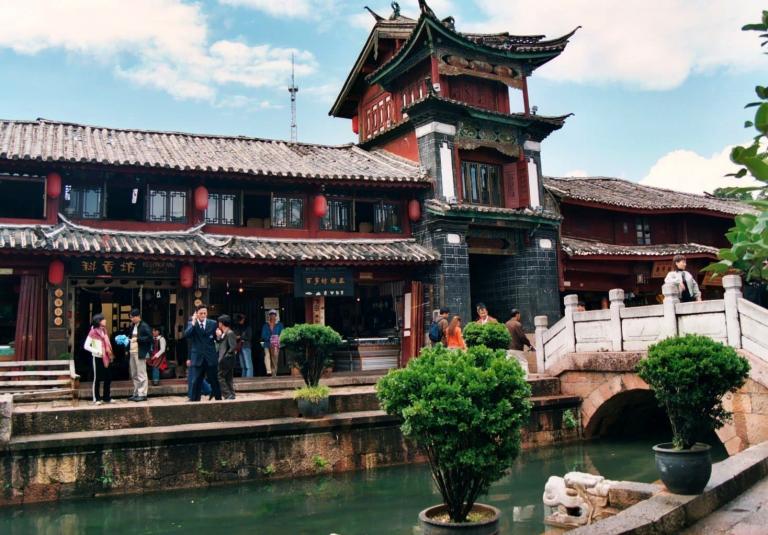
Neither China nor Wuzhen can report reliable population figures from the mid-seventeenth century in part because poll-tax-style revenue collection policies encouraged the understatement of people by the householder and of households by local officials. There were perhaps 400 million by the end of the nineteenth century, the years of the late Qing, and perhaps 50,000 in Wuzhen.
It is possible that each of those figures had doubled from the start of the Qing dynasty 250 years earlier.
The Qing, as had the Yuan before them, adopted much of the Ming Han-derived culture. Confucian philosophy and administrative methods, for example, were maintained so the impact on Wuzhen from the regime change was limited. There was perhaps a cultural division as a result of the increasing isolation of the northern-based Qing court in the eighteenth century. Whereas the imperial court desired no contact whatsoever with the rumbustious aggressive European empires, the southern Chinese were sucked, willingly and at times unwillingly into trading relations with the West. Such trade focused on Macao, Hong Kong and Shamian Island in Guangzhou but did also extend up to Shanghai.
The marvellously phrased official rebuff to the English was presented by the Qianlong Emperor in 1793 through a letter to Queen Victoria. He considered that there [ was] nothing we lack..… and have no need to import the [ useless] manufactures of outside barbarians. Indeed, when the first train, called “The East Wind’, reached London directly from China in 2017 carrying goods from China, comments were made about the service being one-way as Britain would still have little to offer of interest in exchange. Had Emperor Qianlong permitted greater international trade, there would have been more activity on the Grand Canal from the early 1800s. Wuzhen merchants would surely have benefited. They would have a while longer to wait for such an international trade stimulus.
Qianlong’s dismissive rebuff led eventually to the two Opium Wars from1839to 1842 and then again from 1856 to 1860. The remarkable feature of this period is how ignorant each side was of the other’s culture, strengths and motivations. The dangers which flow from such ignorance in international relations are constant. One example of this ignorance, before opium was used, comes from Britain’s earlier search for tradable goods with the Chinese.
Lancashire cotton manufacturers from northwest England thought every Chinaman’ could be persuaded to wear their cotton night caps. Only a few years before,3,000 left-footed only boots were shipped from Northampton to British army soldiers fighting the Crimean War, and a Sheffield manufacturer shipped a vast consignment of steel cutlery to assist the Chinese consumption of food. It is tempting to wonder to what purpose the ingenious Chinese put them. Pianos were also sent out in quantities which bore no relation to demand.
The only product which the British could exchange was opium. Ignorance of other cultures leading to serious consequences is a lesson twenty-first-century English people must understand.
Thus the cause of the shameful Opium Wars was the British desire for silk, tea and porcelain, and their inability to interest the Chinese in the useless ‘ manufacturers of barbarians’ in exchange. The Chinese wish to sell their goods only in return for silver was intolerable to the British government. The development and export of opium in India paid for a third of that country’s colonial costs through taxes; its onward sale into China in exchange for those coveted Asian luxuries solved the problem of Britain’s diminishing silver reserves. The trade helped Britain further as these luxury goods from China were subject to substantial import duties when they reached England. Certainly there were Chinese who facilitated this trade. Indeed, opium was later to be cultivated in China itself and the trade could not have been conducted without many Chinese assisting its distribution.
However, Britain must carry most of the blame for pushing opium throughout China. It is a huge stain on its colonial history. These events understandably retain much exposure in Chinese school history books, far more than is the case in England. In consequence, academics in present-day China may still skewer a visiting English scholar with an opening question demanding their opinion of these wars. Despite excellent books written on this subject by English authors, too little is known in England about this period.
The development of Shanghai, hitherto a small coastal community beneath consideration to the people of Hangzhou or even Wuzhen, was triggered bythis trade; opium would have been sold and consumed in Wuzhen as it will be discussed there in its twenty-first-century schools. Opium was the solution to a trade imbalance. In the spring of 2017, Presidents Xi and Trump met to discuss international trade. The year before the US imported £385 billion of goods from China and in return traded goods worth only £137 billion. Duringthe pre-meeting exchange of sound-bites, the US complained of ‘ totally one-sided trade’. These are complex issues involving exchange rate policy, possible subsidies, the importance of cheap goods in America and much else. Complex, within a modern context, but hardly new. From such seemingly eternal stories does the historian draw comfort.
These Anglo-Chinese wars provided another contrast between the two cultures. The English were led by men accustomed to the deprivations andhorrors of war. Whatever their personal qualities, they would behave, when necessary, as disciplined, trained soldiers. The Chinese officers on the other hand were largely ignorant of war and would mostly have been highly cultivated and well-educated people more interested in writing than fighting. The best of these Chinese officers, their minds impregnated with Confucian texts, saw power as an exercise of mild paternal authority where reason could trump violence. Of course, deeply unpleasant and violent behaviour frequently took place in China, but such instances were considered exceptional and mistaken. Finally, the disciplined and trained English soldiers were better armed than the Chinese.
China was forced to trade with the outside world after the Opium Wars.
Certainly much of the new trade was shipped directly to the northern ports of Qingdao and Tianjin. However, there was also increased trade coming through Shanghai and passing by Wuzhen on barges along the Grand Canal. Any new prosperity after those wars would have been completely reversed by the next trauma in which the British played a smaller part than during the Opium Wars.
This was the massively bloody Taiping Rebellion which lasted from 1850 to 1864; estimated deaths range from 30 to 100 million, making it-on even the lower count-the bloodiest civil war ever. To place this in context, there were around twenty million deaths, and the same number again of casualties, during the First World War fifty years later. These were superstitious times; the youngmen of Wuzhen press-ganged to fight either for the rebels or the imperial army would probably have carried a charm blessed by their mothers and perhaps a handful of their town’s dark rich soil. Yet many must have died far away from Wuzhen, their bones left to rot beneath the walls of a distant citadel. There would have been sadness in the homes of Wuzhen during these times.
The revolt started in the province of Guangxi to the southwest of Wuzhen and was led by a man who considered himself the younger brother of Christ.
Their assault reached as far north as Beijing, but their heartlands were those two rich coastal provinces of Jiangsu and Zhejiang, where lies of course Wuzhen. The destruction during the rebellion of the town was immense. Records show that of the four town sectors, Xizha and Beizha were destroyed although Dongzha and Nanzha were less damaged. The Huiyuan Pawnshop, one of seven at that time, and situated in an ancient building, was reduced to ruins. So too was the Zhaoming Academy destroyed by the Taiping. In the late twenty century, this site, once the summer home of the imperial crown prince, was used to create a library.
There was still more damage to the Fenshui Academy, which was founded in Wuzhen in the late 1780s. It was destroyed during fighting in 1860 and then replaced in 1865 with the Lizhi Academy. Still later this academy, whileretaining its original structure, became the site of a memorial to the late-twentieth-century writer Mao Dun. The revolt also destroyed the silk industry in Wuzhen; their records of the number of looms in operation dropping significantly. The hardship to the local people of the town who depended on the silk cocoon harvests in spring and autumn must have been heart-breaking.
The English connection to these events came through its general, Charles George Gordon, known then as “Chinese Gordon’. Serving later in the Sudan, he went on to acquire the better-known moniker of ‘ Gordon of Khartoum’.
He formed the Ever Victorious Army, made up largely of Chinese troops.
He used the waterways and canals of the Wuzhen area to move his troops around southern China. Much of the fighting took place in the Yangtze valley,
particularly near Suzhou. Such was Gordon’s success in defeating the Taiping that he was greatly honoured by the Tongzhi Emperor; the financial gifts of the emperor, all refused by this honourable man, were overshadowed by the gifts of the merchants of Shanghai who could once more conduct their trade. Gordon declined everything. He represented the very best sort of English imperial army officer at the time. Deeply religious, and surely difficult to live with, he was an immensely brave, highly professional soldier with cast-iron integrity. Such were the men of religious faith, talent and integrity who built the British Empire. He died heroically in the Sudan twenty years later. The return to peace Gordon secured would have pleased the merchants of Wuzhen as much as those of Shanghai.
The third outside influence on Wuzhen during this period came through the misionaries. The European version of Christianity had been introduced to China in the late sixteenth century; the outstanding figurehead of this endeavour was the Italian Jesuit Matteo Ricci. He resided at the court of the Wanli Emperor in Beijing and lived in China for almost thirty years up to his death in 1610. The Jesuits provided the knowledge of China’s civilisation which informed the West and so inspired Voltaire. In contrast to the twenty-first century when many educated Chinese people know far more about the West than their equivalents in the West know about the East, the Jesuits educated Europeans about much of Chinese culture. There was little reciprocal interest from China at that time. The virtues of Chinese society and its government were probably exaggerated by Voltaire, intent as he was on damning the absolutism of Louis XIV. Inflated or not, his reports on China proved fascinating. Madame de Pompadour, mistress of Louis XV, led the obsession with Chinese art. Enlightenment philosophers idealised a society whose rulers were chosen on merit and which was served by a well-organised education system. Furthermore, it was a society Voltaire admired because it could arrange matters without recourse to a class of nobles. This image of a distant culture was immensely attractive to many in Europe: Europeans, exhausted by their own wars and, ignorant of China’s often violent history, perceived in Asia a land of well-governed tranquility. The extensive knowledge of the eighteenth-century educated European on China when the Chinese showed minuscule interest in the West has been completely turned on its head. Since China’s ‘ reform and opening up’ policy, the Chinese interest in Europe has far outweighed reciprocal interest from the West. The more intelligent amongst England’s elite know this must change as rapidly as possible.
Although the long residence of Matteo Ricci began in the Portuguese southern trading colony of Macao, most of his many years in China were passed in Beijing at the Ming imperial court. Travelling north, he would most likely have passed by Hangzhou and possibly even stopped at Wuzhen as did many travellers on the Grand Canal. His approach to implanting Christianitywas to convert the elite, represented by the emperor and his courtiers. This was an intelligent approach since then, and now, China is essentially a society directed from its summit. The snag to his strategy was that he failed to converteither the emperor or courtier, or at least sufficient courtiers. The approach of missionaries in the nineteenth century was the opposite, reflecting in part their different social background and sex, to those of the sixteenth. By the mid-1800s the majority of European missionaries were women; their presence at the Qing imperial court would have been inconceivable. This fact, together with their middle-class education background, made ordinary Chinese people a far better target for conversion to Christianity. With estimates of Chinese Christians atover 90 million today, it would seem theirs was a superior approach to that of the Jesuits, albeit the option of converting ordinary Chinese at the time of the Ming had never been open.
There were many Christian missionaries in the land around Wuzhen. John Leighton Stuart, born of American missionaries in 1876 at Hangzhou, was a particularly renowned missionary; he thought of himself as Chinese, even speaking the language with the Zhejiang dialect. His son and grandson also became missionaries. Like many, Stuart combined the roles of missionary withthat of educator. Other missionaries, such as the Englishman Arthur Moule, at a similar time to Stuart, were based in the area around Ningbo and Shanghai; in travelling from one to the other, it is more than probable that they visited the small town of Wuzhen.
Although Wuzhen was dotted with Taoist and Buddhist temples, there were virtually no Christian churches anywhere to be seen. People like Stuart and Moule sought out the best opportunities for conversion. The large populationsof urban communities, where the offer of medical help with literary and craft education, provided better opportunities than did the small numbers of a rural conservative community. This perceived lack of such recruitment opportunities meant that European missionaries left no obvious mark on Wuzhen. The town was probably too small and perhaps offered too few of its members the basic education platform which Christianity demanded.
The lack of firm government in the nineteenth century as the Qing dynasty approached its demise must have made life difficult in Wuzhen. Doubtless thetrade of its silk, tea and bamboo handicrafts continued, augmented by Western goods traded in the hinterland towards Shanghai. Towards the end of the century the European’s’ Scramble for Africat was coupled with its ‘ Dissection of China. Hong Kong and the New Territories were swallowed by Great Britain, while the Portuguese tightened their ancient grip on Macao. Several European powers occupied Gulangyu Island near the delightful city of Xiamen, Fujian province, and also took over Shamian Island in Guangzhou. Further north, the Germans occupied Qingdao, and, with Britain, other parts of Shandong province, the birthplace of Confucius and the large peninsula just to the south of Beijing. In Dongbei, the northeast of China, first Japan and then Russia took over Port Arthur. The memory of these humiliations remains vivid in modern China. It is this memory, determinedly reinforced during schooling years, that helps explain, if not always excuse, many of China’s policies as well in the twenty-first century.
Wuzhen, as a place of trade, might not have suffered overly from European intrusion. Shanghai was thriving, traffic on the Grand Canal flowed, and plague, drought and floods generally stayed at a distance. Such disturbances as the Boxer Rebellion(1899-1901) were northern events. However, the First World War must have affected trade. The Chinese contribution to the Allied cause during the war— over 500,000 men laboured on the Eastern and Western fronts from 1917-is another fact largely ignored in European classrooms. Perhaps some of these people came from Zhejiang and Wuzhen but most came from Shandong and Hebei provinces; the exchange of labour, then in desperately short supply for the Allies, was to be in return of Shandong province from German rule after the war.
Almost incredibly the men negotiating the terms of peace at Versailles in 1919 determined to transfer suzerainty of this rich and culturally very significant area on the doorstep of its capital Beijing from the Germans to the Japanese. In the West this is forgotten, but its significance in China is immense. Outrage at European behaviour triggered the May Fourth Movement of 1919 which beganwith Peking University students in Tiananmen Square. It spread throughout China. It was an intellectual turning point and acknowledged as such by Mao.
It provided a most significant milestone towards the success of Communism in China.
A more disruptive form of interference came through full invasion by the Japanese in 1894 of Korea, and Taiwan and other parts of China. As with the Boxer Rebellion although it was the north that suffered most, southern trade must have been greatly disrupted. The Qing desire to modernise their countryafter the First Sino-Japanese War in 1895 led to a rapid development of its railway network. This provided an alternative to transport on the Grand Canaland would have diverted trade passing by Wuzhen as barges on the canal wound their way north. In keeping with its generally humiliating approach to China in those times, the European powers insisted on the railway concessions being granted to Western railroad companies. Building railways was considered by the Europeans their legitimate arena of interest within China.
The first railway in the 1890s went from Shanghai northwards to Nanjing and would indeed have diverted traffic, both people and goods, from the Grand Canal and Wuzhen. Ten years later the Hangzhou, south of Wuzhen, to Shanghai railroad opened; its 200 kilometre stretch of track went past Haining, but was thirty kilometres distant from Wuzhen. This is emblematic of Wuzhen’s economic status in the twentieth century. Economic events, if not always political, bypassed the town. The replacement of water ways by railroads is not a happy development for a water town like Wuzhen.
Better roads and new railways pushed the canal and its adjacent water towns like Wuzhen towards economic irrelevance. The northern section of the canal across Shandong was destroyed by flooding during the Qing and its southern parts languished without adequate maintenance. Its navigability aboveJining in southern Shandong was never restored although the southern sections did benefit from the attention of the government after 1949.
The commercial decline of the canal mirrored Wuzhen’s own economic life in the last century. Its silk, tea and handicrafts were usually in demand but the bustle, hustle and trading benefits of having this giant vibrant waterway next to its own streams was much reduced. The cultural life of Wuzhen and awareness of a wider life beyond its small town atrophied. The canal itself, forever its touchpoint to the outside world, lost its relevance. Wuzhen became a more insular place.
Sun Yat-sen’s failed republic, the period of strife in the 1920s and the struggle between the warlords and Chiang Kai-shek would each have made life difficult for Wuzhen people. Japanese aggression, however, again made their lives hellish over eight years from 1937. At the war’s beginning Japanese soldiers killed up to 300,000 Chinese in Nanjing, only 250 kilometres away from Wuzhen. The town itself was occupied, doubtless brutally, by the Japanese.
The harbour near Fulan Bridge was destroyed. One of the town’s best-known modern writers, Mu Xin, describes their atrocities in his collection of short stories, An Empty Room. He writes of his father’s mistress Miss Xia who he kept in Shanghai; she fled to Wuzhen to avoid the Japanese. She was still arrested, raped, her arms cut off and her body thrown into the snow. Another of Wuzhen’s celebrated writers, Mao Dun, wrote in The Shop of the Lin Family of how Mr Lin’s daughter could not wear the clothes stocked in his shop which were made in Japan to her school without severe repercussions. Left out of economic growth it may have been, but Wuzhen was as ever sucked into national events.
Communism established properly since 1949 did initially help until 1960s and 1970s when some of its intellectuals such as the writer Mu Xin suffered greatly during the ‘ Great Famine’ and then the madness of the ‘ Cultural Revolution’. However, the Communist Party determined to restore the canal and life edged back into the town’s commercial and social life. Nonetheless, this wasthe period after the generally wealthy days of the Ming and Qing since the mid-1660s, during which Wuzhen’s homes deteriorated, bridges crumbled and the waterways darkened.
Wuzhen’s next revival came in the early years of the present century,a result twenty years later of Deng Xiaoping’s ‘ opening up’ policy in 1978. Deng’s policytriggered the creation of considerable wealth; definitions vary, both of numbers and the concept itself, but most estimates of the Chinese middle class with money to spend suggest this group constitutes around 300 million households, or almost 800 million individuals. As the British state resented the transfer of its silver reserves to China before the Opium Wars, so China’s government wished more tourism expenditure to be consumed domestically. The water towns of Zhejiang province, amongst which Wuzhen had long been a star, formed a natural beacon for domestic tourism.
There are delights to be enjoyed by a Chinese as by a European visiting this area, where the brash dynamism of Shanghai contrasts with nearby Suzhou, home of the most wonderful gardens in China. Suzhou lies on the edge of Lake Tai a few dozen kilometres from Wuzhen.A short distance further south lies Hangzhou, imperial capital of two dynasties with much to enthral the visitor.
Shaoxing,a city with great literary history and home of the Yue culture is close by as well. The family of Zhou Enlai, the first premier of the People’s Republic of China, came from Shaoxing, as did Lu Xun, one of Chinas most significant modern writers and the female revolutionary Qiu Jin, who was executed in 1907. People who have moulded modern China came from Wuzhen and its hinterland.
Its ability to thrive on the back of contemporaneous events in China was nonetheless exhausted by the late twentieth century. Decrepit and out of step with modern China, the town was dying. Its terminal decline was arrested by the decision of a few people, led by a far-sighted and clearly inspired local man Chen Xianghong, to restore the town. Wuzhen was reborn as an attractive late-Qing era water town. Its buildings, old bridges, and waterways educate modern Chinese stuffed in high-rise apartments about the past, just as do its many museums. Through hosting the annual World Internet Conference, and engaging with other aspects of the internet, it is also embracing the future culture of China. The development of an important theatre festival also ensures that traditional cultural forms have not been ignored. The town represents modern, just as much as past China. It celebrates its past whilst facing forward to the modern age.
Some places in every country have been, perhaps to their advantage, bypased by history. This is not true of Wuzhen. At the time of the Zhou over 2,000 years ago and the struggles between the Wu and the Yue, the building of the Grand Canal, or the arrival and departure of the imperial capital from nearby Hangzhou, the town was near the centre of the country’s convulsions.
The famous generals who died defending the town and the imperial Prince Zhaoming who studied there were familiar with the community before they met their destiny. The tragedies of opium, the Taiping revolt and the brutality of the Japanese were witnesed within the town. Wuzhen has frequently been touched by history. Through the looking-glass of Wuzhen much may be learnt of China.
Its future, seen from the viewpoint of the early twenty-first century, looks blessed. Its structure has been sensitively and beautifully restored. President Xi, who happened to be a senior leader in Zhejiang province before becoming president, evidently supported its adoption as the home for the World Internet Conference. Nearby Hangzhou was again in the world’s eye when it hosted the 2016G20 meeting; its delegates were encouraged to visit the water town. People have travelled to Wuzhen by high-speed rail, water, coach or car.
In most times, they would have stopped to enjoy its beauty and peace before travelling on south to Hangzhou or north towards Suzhou. It was ever a restful and charming place,a place which has now re-found it soul. People are pausing at Wuzhen again.
